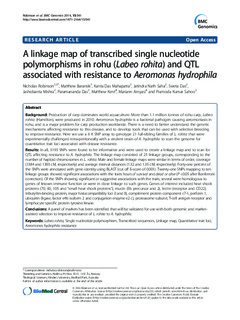| dc.description.abstract | Background
Production of carp dominates world aquaculture. More than 1.1 million tonnes of rohu carp, Labeo rohita (Hamilton), were produced in 2010. Aeromonas hydrophila is a bacterial pathogen causing aeromoniasis in rohu, and is a major problem for carp production worldwide. There is a need to better understand the genetic mechanisms affecting resistance to this disease, and to develop tools that can be used with selective breeding to improve resistance. Here we use a 6 K SNP array to genotype 21 full-sibling families of L. rohita that were experimentally challenged intra-peritoneally with a virulent strain of A. hydrophila to scan the genome for quantitative trait loci associated with disease resistance.
Results
In all, 3193 SNPs were found to be informative and were used to create a linkage map and to scan for QTL affecting resistance to A. hydrophila. The linkage map consisted of 25 linkage groups, corresponding to the number of haploid chromosomes in L. rohita. Male and female linkage maps were similar in terms of order, coverage (1384 and 1393 cM, respectively) and average interval distances (1.32 and 1.35 cM, respectively). Forty-one percent of the SNPs were annotated with gene identity using BLAST (cut off E-score of 0.001). Twenty-one SNPs mapping to ten linkage groups showed significant associations with the traits hours of survival and dead or alive (P <0.05 after Bonferroni correction). Of the SNPs showing significant or suggestive associations with the traits, several were homologous to genes of known immune function or were in close linkage to such genes. Genes of interest included heat shock proteins (70, 60, 105 and “small heat shock proteins”), mucin (5b precursor and 2), lectin (receptor and CD22), tributyltin-binding protein, major histocompatibility loci (I and II), complement protein component c7-1, perforin 1, ubiquitin (ligase, factor e4b isoform 2 and conjugation enzyme e2 c), proteasome subunit, T-cell antigen receptor and lymphocyte specific protein tyrosine kinase.
Conclusions
A panel of markers has been identified that will be validated for use with both genomic and marker-assisted selection to improve resistance of L. rohita to A. hydrophila. | |
